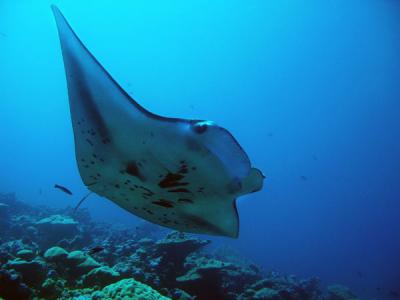Non-Native Trees Lead to Fewer Manta Rays

A large network of complex interaction of animals and their environments has been discovered in an island habitat. The ecological web includes trees, seabird poop and manta rays.
The researchers found that as non-native palm trees have been planted on the once-pristine island habitat, fewer seabirds are roosting in certain areas, those areas then have less seabird poop to fertilize the soil, fewer nutrients washing into the waters, leading to smaller and fewer plankton in the water, and finally since the plankton are food for the rays, there are fewer rays in those areas.
"This is an incredible cascade," said researcher Rodolfo Dirzo, of Stanford University, said in a statement. The problems: human intervention. "As an ecologist, I am worried about the extinction of ecological processes."
The study was published May 17 in the journal Scientific Reports.
This is an example of how human disturbance (brining in non-native plants to the island) can lead to widespread, yet largely invisible, disruptions of ecological interaction chains. This, in turn, highlights the need to build non-traditional alliances — among marine biologists and gardeners, for example — to address whole ecosystems across political boundaries.
The find was serendipitous: Stanford University researchers working on the Palmyra Atoll, a remote and essentially unoccupied coral island the Pacific, brought their separate disciplines together over the dinner table, trading theories about how their separate observations could be related.
"As the frequencies of these different conversations mixed together, the picture of what was actually happening out there took form in front of us," study researcher Douglas McCauley, also of Stanford University, said in a statement.
Get the world’s most fascinating discoveries delivered straight to your inbox.
Through analysis of nitrogen isotopes, animal tracking and field surveys, the researchers showed that replacing native trees with non-native palms led to about five times fewer roosting seabirds (they seemed to dislike palms' simple and easily wind-swayed canopies), which led to fewer bird droppings to fertilize the soil below, fewer nutrients washing into surrounding waters, smaller and fewer plankton in the water and fewer hungry manta rays cruising the coastline.
"Such connections do not leave any trace behind," study researcher Fiorenza Micheli, also of Stanford, said in a statement. "Their loss largely goes unnoticed, limiting our understanding of and ability to protect natural ecosystems."
McCauley put it another way: "What we are doing in some ecosystems is akin to popping the hood on a car and disconnecting a few wires and rerouting a few hoses. All the parts are still there — the engine looks largely the same — but it's anyone's guess as to how or if the car will run."



